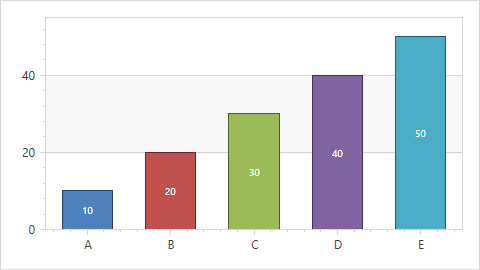SeriesLabel Class
Contains settings for series point labels.
Namespace: DevExpress.Xpf.Charts
Assembly: DevExpress.Xpf.Charts.v25.2.dll
NuGet Package: DevExpress.Wpf.Charts
Declaration
public class SeriesLabel :
ChartTextElement,
ICustomTypeDescriptor,
INotifyPropertyChanged,
ICloneable,
ISeriesLabel,
ISupportFlowDirectionRelated API Members
The following members return SeriesLabel objects:
Remarks
An instance of the SeriesLabel class is available via the Series.Label property.
The SeriesLabel class provides different settings that define the position of series labels (SeriesLabel.Indent) and connector settings (SeriesLabel.ConnectorVisible, SeriesLabel.ConnectorThickness).
Also, to automatically prevent labels of different series points from overlapping, you can use the SeriesLabel.ResolveOverlappingMode property, which should be set to a value other than ResolveOverlappingMode.None. Note that resolving overlapped labels is available only for chart types plotted by the XYDiagram2D.
Example
The following example demonstrates how to change the appearance of series labels.

To accomplish this, it is necessary to create a DataTemplate that specifies the appearance of series labels, and add it to a window’s resource. Then, this template can be applied to a series label via its ChartTextElement.ElementTemplate property.
Note
The chart control displays a crosshair cursor instead of series labels in the diagram by default. To provide series labels customization, enable series labels (set the Series.LabelsVisibility property to true) and disable the crosshair cursor (set the ChartControlBase.CrosshairEnabled property to false).
<Window x:Class="CustomLabelTemplate.Window1"
xmlns="http://schemas.microsoft.com/winfx/2006/xaml/presentation"
xmlns:x="http://schemas.microsoft.com/winfx/2006/xaml"
xmlns:dxc="http://schemas.devexpress.com/winfx/2008/xaml/charts"
Title="Window1" Height="331" Width="488">
<Window.Resources>
<ResourceDictionary>
<DataTemplate x:Key="template">
<Border BorderThickness="1" CornerRadius="9" Opacity="1.0">
<Border.Background>
<SolidColorBrush Color="{Binding Path=Color}"/>
</Border.Background>
<Label Content="{Binding Path=Text}" Padding="5,1,5,1.5"
Foreground="White" FontSize="10" />
</Border>
</DataTemplate>
</ResourceDictionary>
</Window.Resources>
<Grid>
<dxc:ChartControl CrosshairEnabled="False">
<dxc:ChartControl.Diagram>
<dxc:XYDiagram2D>
<dxc:XYDiagram2D.Series>
<dxc:BarSideBySideSeries2D LabelsVisibility="True" ColorEach="True">
<dxc:BarSideBySideSeries2D.Points>
<dxc:SeriesPoint Argument="A" Value="10" />
<dxc:SeriesPoint Argument="B" Value="20" />
<dxc:SeriesPoint Argument="C" Value="30" />
<dxc:SeriesPoint Argument="D" Value="40" />
<dxc:SeriesPoint Argument="E" Value="50" />
</dxc:BarSideBySideSeries2D.Points>
<dxc:Series.Label>
<dxc:SeriesLabel ConnectorVisible="False" ElementTemplate="{StaticResource template}" />
</dxc:Series.Label>
</dxc:BarSideBySideSeries2D>
</dxc:XYDiagram2D.Series>
</dxc:XYDiagram2D>
</dxc:ChartControl.Diagram>
</dxc:ChartControl>
</Grid>
</Window>
Related GitHub Examples
The following code snippets (auto-collected from DevExpress Examples) contain references to the SeriesLabel class.
Note
The algorithm used to collect these code examples remains a work in progress. Accordingly, the links and snippets below may produce inaccurate results. If you encounter an issue with code examples below, please use the feedback form on this page to report the issue.